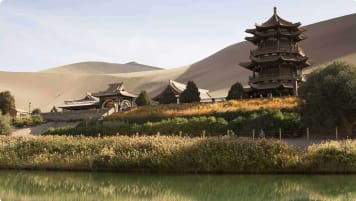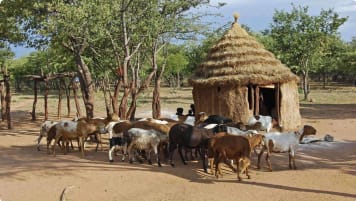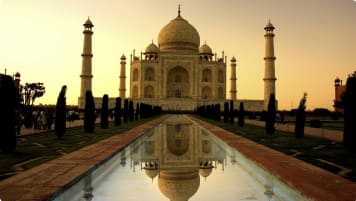Discovering India as a Mature or Senior traveller
Discovering India as a Mature or Senior traveller India is a land of immense diversity and extremes – geographical, economic and spiritual. Its geography encompasses the glacial heights of the Himalaya in the north, the…
22 Feb 18 · 28 mins read
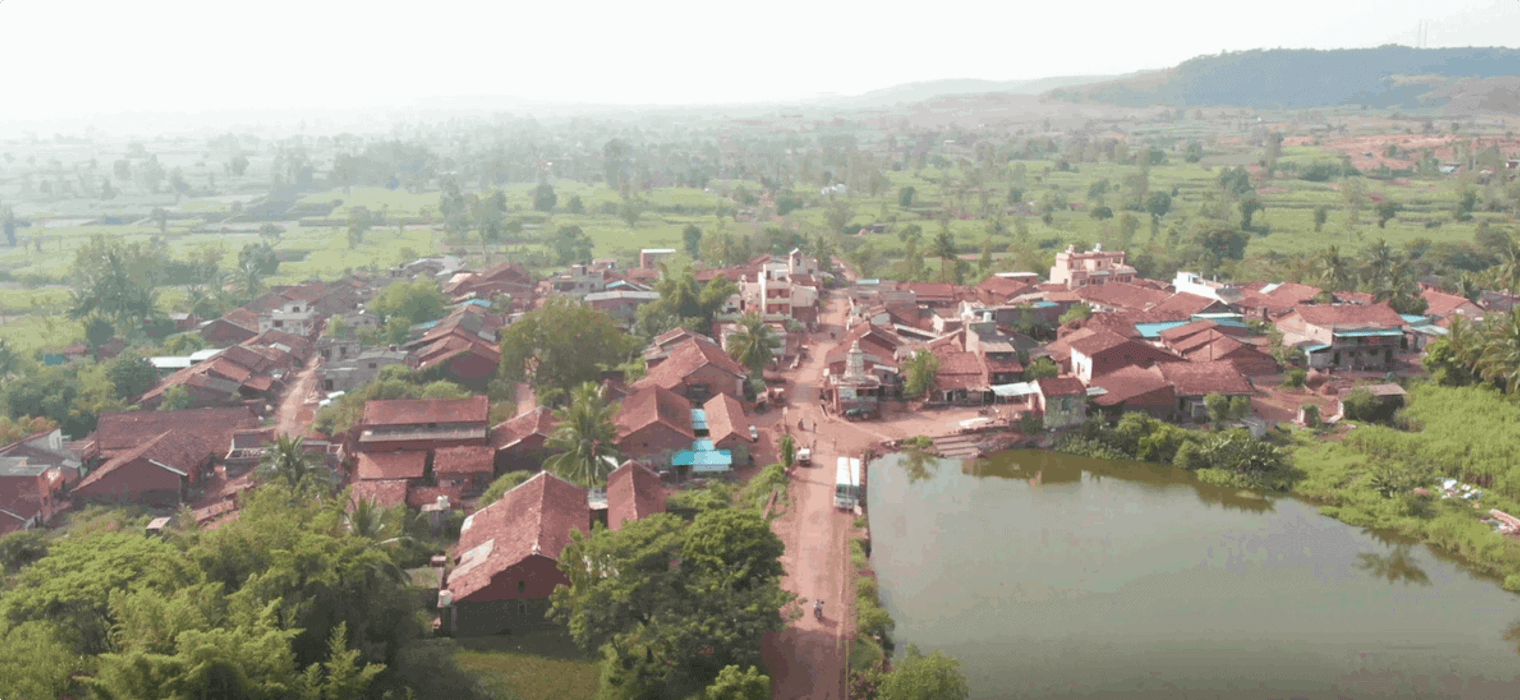
Discovering India as a Mature or Senior traveller
India is a land of immense diversity and extremes – geographical, economic and spiritual. Its geography encompasses the glacial heights of the Himalaya in the north, the arid plains of the west, and palm-fringed tropical beaches in the south – a vast tapestry of mountains, plains, forests and deserts. It is a land of ancient traditions and countless mother tongues. A nation where the culture, dress, language and cuisine change with the diverse terrain. This article is designed to pique your interest in this exotic destination. We explore some of India’s most appealing and popular cities, along with a few off the beaten track. Then we examine India’s history and unique culture.
Odyssey Traveller offers small group tours with a focus on education. They are designed especially for adventurous seniors and mature travellers, and include the services of a tour leader and experienced local guides. For a list of our tours to India, click here.
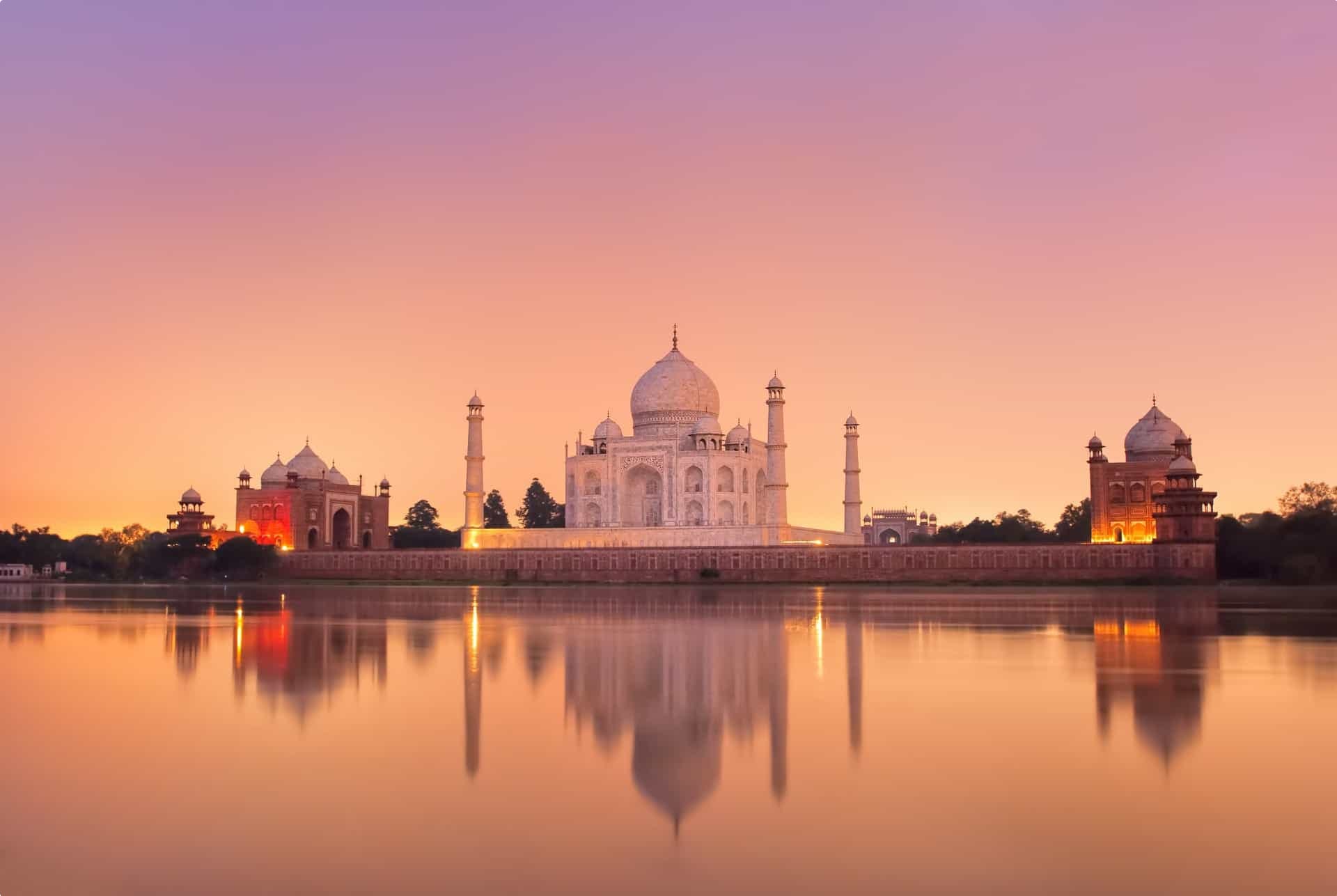
India: a spiritual and religious birthplace
India’s population exceeds a staggering billion people. It is home to over 18 official languages, with dialects and accents that change in the space of kilometres. The ethnic make-up of the country is reflected in the diversity of the original inhabitants. These were the Dravidians, in southern India, and descendants of the Ayran and Mughal invaders in the north.
The spirituality here is palpable, with most of the world’s major religions practised fervently. India is the birthplace of Hinduism, Buddhism, Sikhism and Jainism and is among the few places in the world to have a resident Zoroastrian population. Saint Thomas the Apostle is purported to have brought Christianity to the south in 54 AD. Jesus Christ is said to have travelled to India twice.
Immerse yourself in India’s charming culture
Part of the charm of India lies in its rich cultural traditions. Village life remains much the same as it has been for thousands of years. Even in the larger cities, ancient customs and rituals are still part of daily life and can be perplexing for the visitor. On closer inspection you will find that a very complex etiquette, with social, religious and political implications, can be traced to the core of these practices. India is a land of paradox: a unique mix that defies easy definition or description. It is modern and ancient, rich and poor; it has elephants and Mercedes sharing the roadways. Mysterious and enthralling, it is a destination quite unlike any other.

1. Delhi
Delhi is the capital of India, and the country’s third-largest city. It is home to some of the finest monuments of the Moghul Empire and the British Raj. Delhi is also one of India’s busiest entrance points for overseas airlines, the hub of the north Indian travel network and an excellent base from which to visit Agra and Jaipur – two of India’s most popular cities. It stands at the western end of the Gangetic Plain, bordered on the eastern side by the state of Uttar Pradesh, and on the other three sides by the state of Haryana.
Travellers to Delhi get two cities for the price of one. Old Delhi, the capital of Muslim India, between the mid-17th and late-19th centuries, is full of spectacular mosques, monuments and forts. It is a lively area of colourful bazaars, narrow streets and excitement. In contrast, New Delhi, the imperial city created by the British Raj, is composed of spacious, tree-lined avenues and imposing government buildings.
A powerful capital

Apart from short periods in its history, Delhi has always been the seat of power and the city reflects its onerous role. It is said that there has been not one but seven cities of Delhi, built under different dynasties and different rulers. In truth there may perhaps have been more. From its ancient past in Indian folklore as the capital of the legendary kingdom of Indraprastha, through chapters of medieval history to which time-ravaged monuments bear evidence to its modern resurrection, Delhi has certainly endured for many hundreds of centuries.
Delhi today
Today, Delhi is a blend of an exciting past and a pulsating present. Modern buildings with their glass walls sit harmoniously adjacent to old monuments, each with its own distinct character. Delhi’s tree-lined roads provide a green canopy; its traffic islands have been turned into gardens and the city provides a dimension of space even as it exudes an aura of history. It is a political, as well as an administrative capital. It is also a centre for academics and the arts. Everything that happens in India finds a reflection in this dynamic city.
Must see in Delhi

There is much to see in Delhi, from the large impressive Red Fort with its palaces and public halls, the perfection of the Jama Masjid (mosque), the monumental Qutab Minar, to the peaceful gardens of Raj ghat. Delhi’s modern shops and rows of emporia dazzle with an array of shopping opportunities, for all of India’s splendid shopping is easily at hand here. We recommend setting out on foot, and taking a walking tour with the services of an experienced local guide. Delhi is a city waiting to be uncovered.
2. Jaipur
One of the major tourist destinations of India, Jaipur is known world-wide as the ‘Pink City’ due to the pink wash applied to its buildings. The capital of Rajasthan was founded by the notable astronomer Maharaja Jai Singh in 1727. It was designed in honour of a visiting prince and, ever since, has retained this rosy hue. Centuries on, Jaipur likewise retains its rich history and culture. The past comes alive in its impressive forts, majestic palaces and in its royal building, which was the abode of royal families for centuries. Jaipur is also home to extensive boulevards and beautiful gardens.
Hawa Mahal
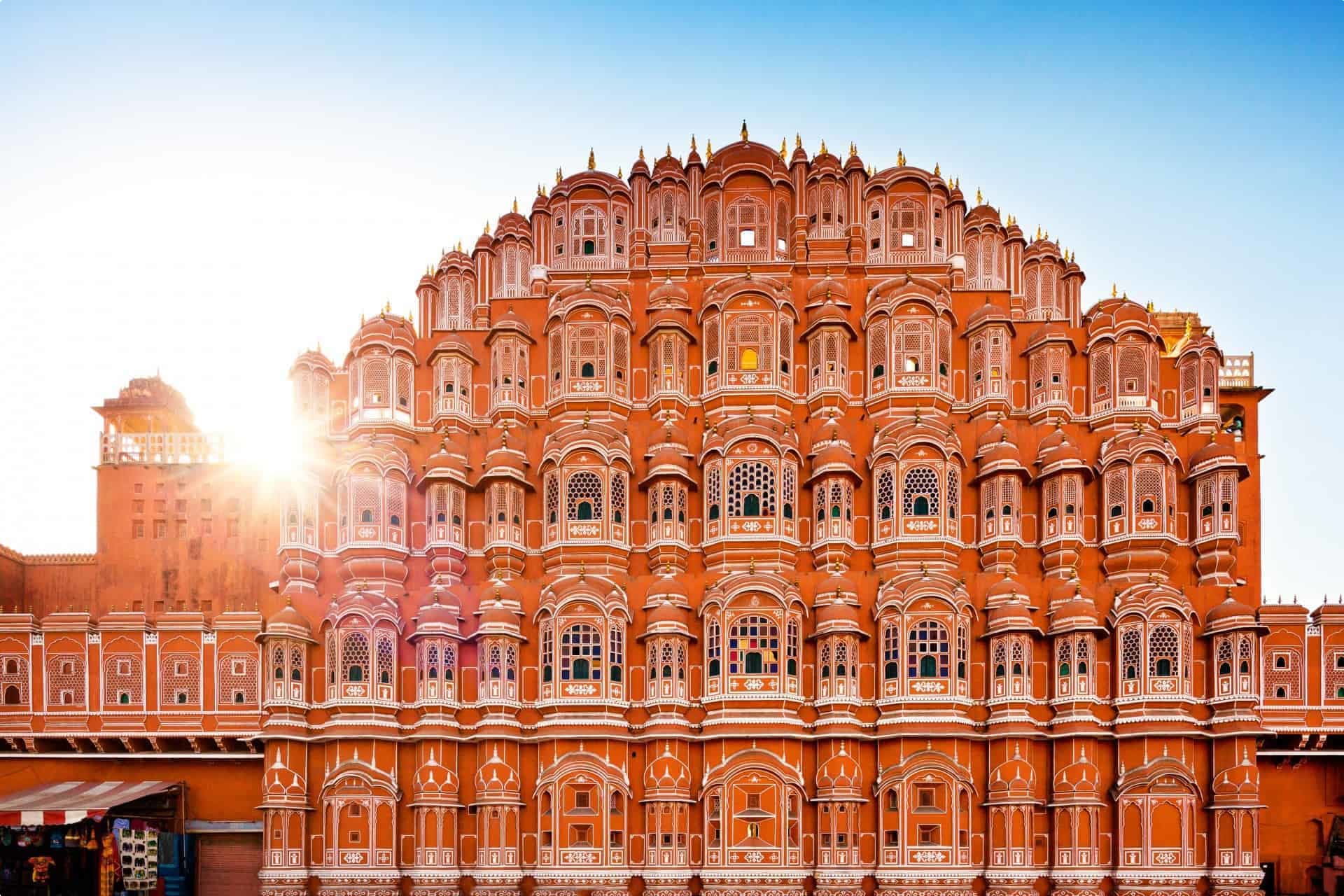
The Hawa Mahal (Palace of Winds) is arguably Jaipur’s best-known monument. It is unlike any other Rajput monument – fort, palace or temple. The magical structure seems straight out of the Arabian Nights – an oriental fantasy in stone. A whimsical addition to Rajasthan’s rich architectural vocabulary, the fanciful Hawa Mahal or “Palace of Winds” was erected in 1799 by the aesthete Sawai Pratap Singh (r.1778-1803). Its ornate pink facade has become an icon for the city. The tiered, Baroque-like composition of projecting windows and balconies with perforated screens is 5 stories high but just 1 room deep. Its’ walls are no more than 20 centimetres (8 inches) thick, built of lime and mortar. The structure was designed in this way to enable the veiled ladies of the harem to observe, unnoticed, the lively street scenes below.
Dedicated to Lord Krishna, the Hawa Mahal, seen from afar, looks like the mukut (crown) that often adorns the god’s head. Visitors can climb the winding ramp to the top, and a gateway towards the west leads into the complex. Within it are administrative offices and the Archaeological Museum. The latter houses a small collection of sculptures and local handicrafts, including some utensils dating back to the 2nd century BC.
Jantar Mantar
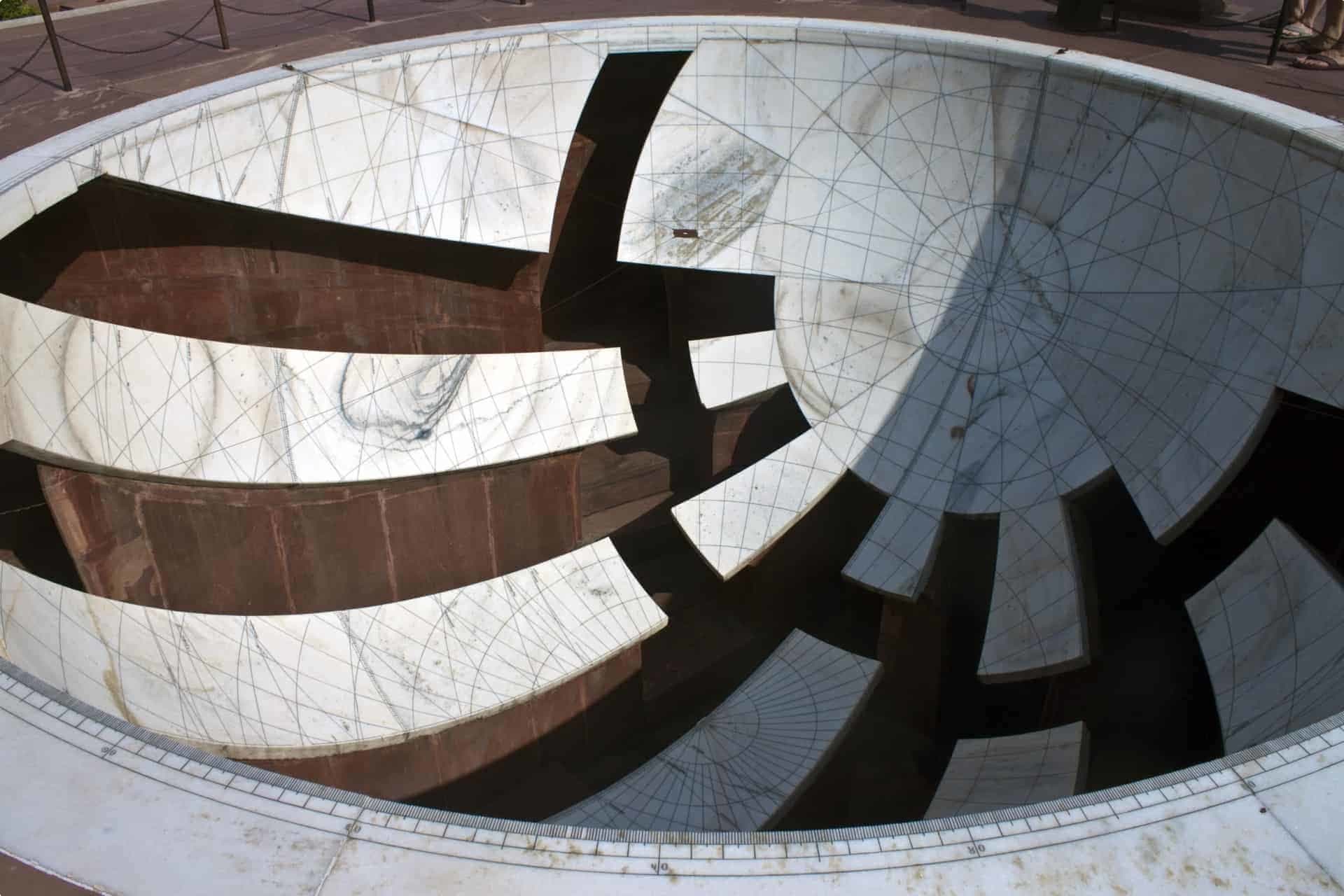
Jantar Mantar translates as the ‘instruments for measuring the harmony of the heavens’. Built between 1728 and 1734, this observatory has been described as “the most realistic and logical landscape in stone.” Its sixteen instruments resemble a giant sculptural composition. Of the five observatories built by Sawai Jai Singh II, the one in Jaipur is the largest and best preserved. The others are located in Delhi, Ujjain, Mathura, and Varanasi. A keen astronomer himself, Jai Singh kept abreast of the latest astronomical studies in the world, and was most inspired by the work of Mirza Ulugh Beg, the astronomer-king of Samarkand. Some of the instruments of Jantar Mantar are still used today. They assist in forecasting the intensity and duration of the summer and monsoon seasons, and also warn of the possibility of floods and climate-induced famine.
3. Agra
Agra is home to the famed Taj Mahal, one of the world’s most beloved icons of architecture. But the city itself has its own appeal, as well as a rich history. The earliest reference to Agra is found in the Hindu epic, Mahabharata, which refers to it as Agrabana – the city of paradise. However, the town remained insignificant until Sikandar Lodi of the Delhi Sultanate made it his seat of power in 1505. It was here that Babur defeated the Rajput king Rana Sangha in the Battle of Khanua in 1527. This sowed the seed of the Mughal Empire, which blossomed over the next 200 years. In the 16th and 17th centuries, the sumptuous courts of Akbar, Jahangir and Shah Jahan transformed Agra into a sophisticated, luxurious, man-made paradise.
Agra today
When the fortunes of the Mughals dwindled in the 18th century, the pre-eminence of Agra too declined. Today, however, the town is a bustling industrial and commercial hub. A visit to the city is like being transported back in time. Situated on the banks of the Yamuna, its narrow, crowded streets and boulevards are medieval in structure, while its bazaars are splashed with colour and gaiety –the hallmarks of the city. All sorts of goods, especially leather items, local handicrafts and imitation inlay work on marble (including miniaturised Taj Mahals) jostle for shelf space in the shops. The pethas (pumpkin sweet), dalmoth (fried peas) and sumptuous Mughlai food are all worth a try.
It is thought that in the middle ages, Agra would have rivalled Casablanca or Cairo in its character. Although Muslims comprise just a tenth of the population of Agra today, the town retains its Islamic charm. This makes its reminiscent of the time when Islam held centre-stage in Indian politics – during the halcyon days of the Mughal Empire.
Taj Mahal
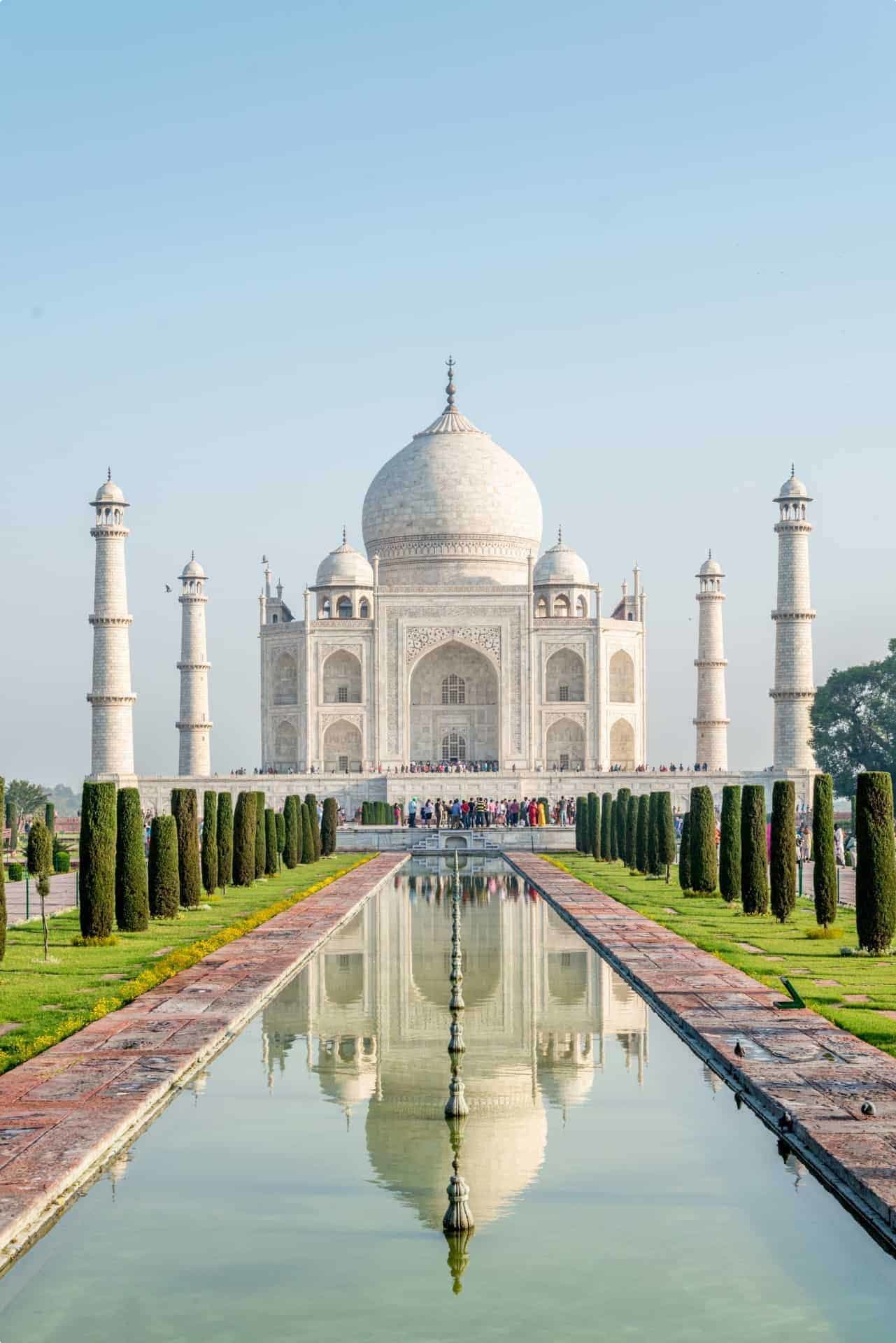
The Taj Mahal is often described as the most extravagant monument ever built for love. The poignant Mughul mausoleum was constructed by Emperor Shah Jahan in memory of his second wife Mumtaz Mahal. Her unexpected death in childbirth in 1631 left the emperor so heartbroken that his hair is said to have turned grey overnight.
Construction of the Taj began in the same year and it was not completed until 1653. In total, 20,000 people from India and Central Asia worked on the building. The main architect is believed to have been Isa Khan, who was from Shiraz in Iran. Experts were also brought from Europe.
The structure of the Taj
The Taj stands on a raised marble platform in ornamental gardens on the bank of the Yamuna. Tall, purely decorative white minarets grace each corner of the platform – as the Taj Mahal is not a mosque, nobody is called to prayer from them. Twin red sandstone buildings frame the main building: the one on the western side is a mosque; the identical one on the eastern side is purely for symmetry. It cannot be used as a mosque because it faces in the wrong direction.
The central Taj structure has four small domes surrounding the bulbous central dome. The tombs of Mumtaz Mahal and Shah Jahan are in a basement room. Above them in the main chamber are false tombs, a common practice in mausoleums of this type. Light is admitted into the central chamber by finely cut marble screens. The echo in this high domed chamber is superb and there is always somebody there to demonstrate it.
Although the Taj is amazingly graceful from almost any angle, it is the close-up detail which is really astounding. Semi-precious stones are inlaid into the marble in beautiful pattern using a process known as peitra dura. The precision and care which went into the Taj Mahal’s design and construction is just as impressive whether you view it from across the river or from arm’s length. Note that the Taj is closed on Mondays.
Agra Fort

Situated on the West Bank of the Yamuna, Agra Fort was built by Emperor Akbar between 1565, though additions were made up until the rule of his grandson, Shah Jahan. Its imposing red sandstone ramparts form a crescent along the riverfront, and encompass an enormous complex of courtly buildings, ranging in style from the early eclecticism of Akbar to the sublime elegance of Shah Jahan. The barracks to the north are 19th-century British additions. A deep moat, once filled with water from the Yamuna, surrounds the fort.
In Akbar’s time the fort was principally a military structure but during Shah Jahan’s reign it had partially become a palace. The auricular fort’s colossal double walls rise over 20 metres in height and measure 2.5 kilometres in circumference. Unfortunately, not all buildings are open to visitors. This list includes the white marble Pearl Mosque, regarded by some as the most beautiful mosque in India.
Fatehpur Sikri
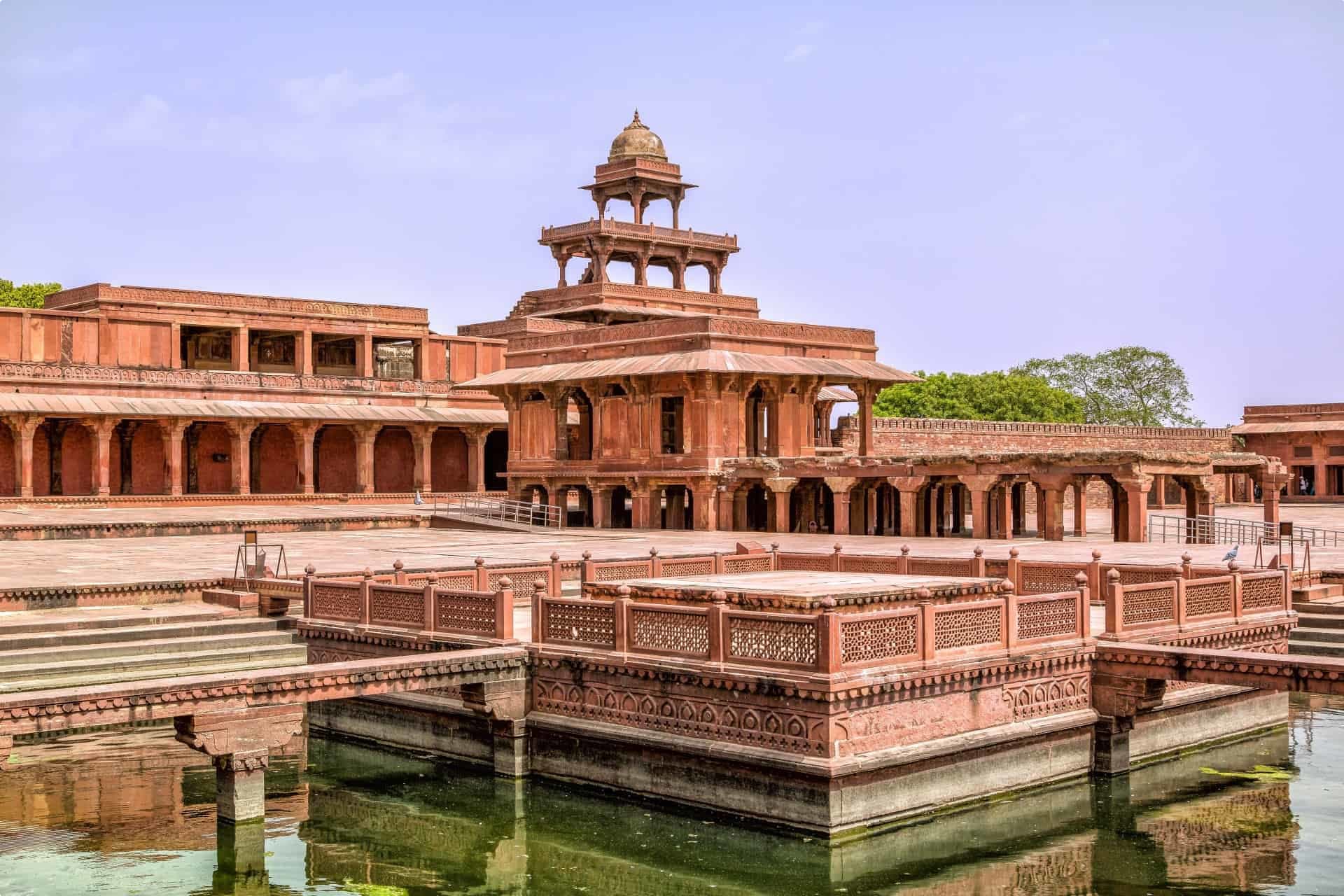
Don’t forget to venture beyond the city itself, to discover the pearls of Agra’s surrounds. Located just 40 kilometres west of Agra is Fatehpur Sikri. This deserted World Heritage Listed town was the capital of the Moghul Empire (1571 – 1581) during the reign of Emperor Akbar. The impressive complex of palaces, monuments, public buildings, and temples includes one of the largest mosques in India, the Jama Masjid, which was completed in 1571. It has the capacity to house 10,000 worshippers. When English traveller Ralph Fitch visited the site in 1585, he described Fatehpur Sikri as “considerable larger than London and more populous”.
The red sandstone Fatehpur Sikri was built in honour of Saint Salim Chisti. Chisti foretold the birth of three sons to Emperor Akbar. The town is an example of robust stability combined with touches of real originality. Each important edifice here represents a style in itself. Notable among them is the Diwan-e-Khas – entirely unique in its concept. It features a tall vaulted room with an intricately-carved central pillar supporting a platform that once held the emperor’s throne.
Nearby, the airy Panch Mahal, a 5-storied structure rising in pyramidal fashion, was probably used by the ladies of the court. Set like a jewel in a courtyard of pink sandstone, it is arguably the finest building here. The marble Tomb of Salim Chisti is enclosed by finely carved, lacy marble screens. The Buland Darwaza, an imposing gateway 54 metres high, was built to commemorate Akbar’s Aligarh. The tomb is a combination of Muslim and Hindu architectural styles.
4. Varanasi

Varanasi’s prominence in Hindu mythology is unrivalled. The city, which is also referred to as Kashi, or Benares, is one of the oldest living cities in the world. Mark Twain described the city as “…older than history, older than tradition, older even than legend and looks twice as old as all of them put together…”
Varanasi is situated on the west bank of the Ganges and is India’s holiest Hindu City, with a spiritual and religious legacy that goes back nearly 3,000 years. This is the city of Shiva, the foremost among the twelve places where the god burrowed and then burst into the sky in a fiery pillar of light (Jyotirlinga). Sanctified by Shiva’s all-pervading presence and the sacred Ganges, the 90 or so ghats along the river define the life and identity of Varanasi. Stretching from the southern Asi Ghat to the northern Adi Keshava Ghat, close to the Malviya Bridge, the ghats cover more than 6 kilometres. Lined with temples and shrines, the ghats reverberate with the endless cycle of Hindu religious practice, from daily rituals to profound rites of passage.
While you are in Varanasi, take an early morning boat ride on the Ganges: a pilgrimage from Ghat to Ghat. People bathe early in the morning to offer prayers to the rising sun. The two cremation ghats are Manikarniks and Harishchandra, where funeral pyres burn day and night. Hindus believe that to die in Kashi and to be cremated on the banks of the Ganges is to attain release from the cycle of birth and death.
Sarnath
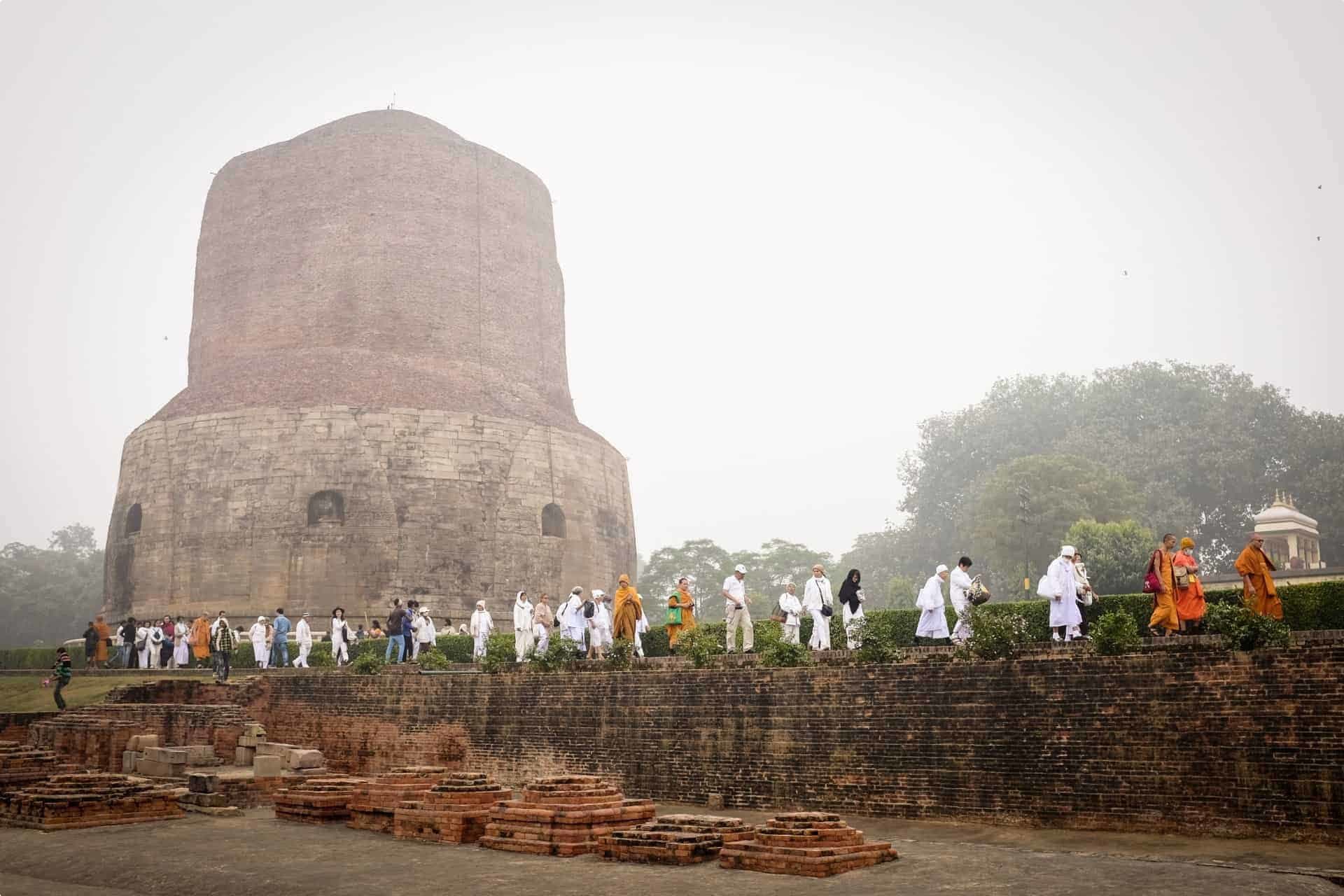
The sacred Buddhist site of Sarnath is located 13 kilometres to the north of Varanasi. At this site, Siddhārtha Gautama Buddha set in motion what Buddhists call the Wheel of Dharma. He did so by delivering, in the 6th century BC, his first sermon to the five companions with whom he had sought enlightenment. Together with him, they formed the first sangha: the company of Buddhist monks. This sacred Buddhist site is marked by the Dharmarajika stupa that was built by the Maurayan emperor Ashoka in the 3rd century.
5. Mumbai
The capital of Maharashtra is India’s most dynamic, cosmopolitan, and crowded city. The country’s financial centre and its busiest port, Mumbai is also home to the world’s biggest cinema industry, popularly known as Bollywood. Some 18+ million people, from billionaire tycoons to homeless pavement dwellers, live in this teeming megalopolis. It demonstrates a striking contrast between great wealth and abject poverty.
Most of coastal Mumbai is built on reclaimed land. Originally, the area was seven small islands surrounded by tidal creeks and mangrove swamps. The region had been occupied for centuries before the arrival of the Portuguese in the 16th century. The Portuguese called their settlement Bom Bain (Good Bay).
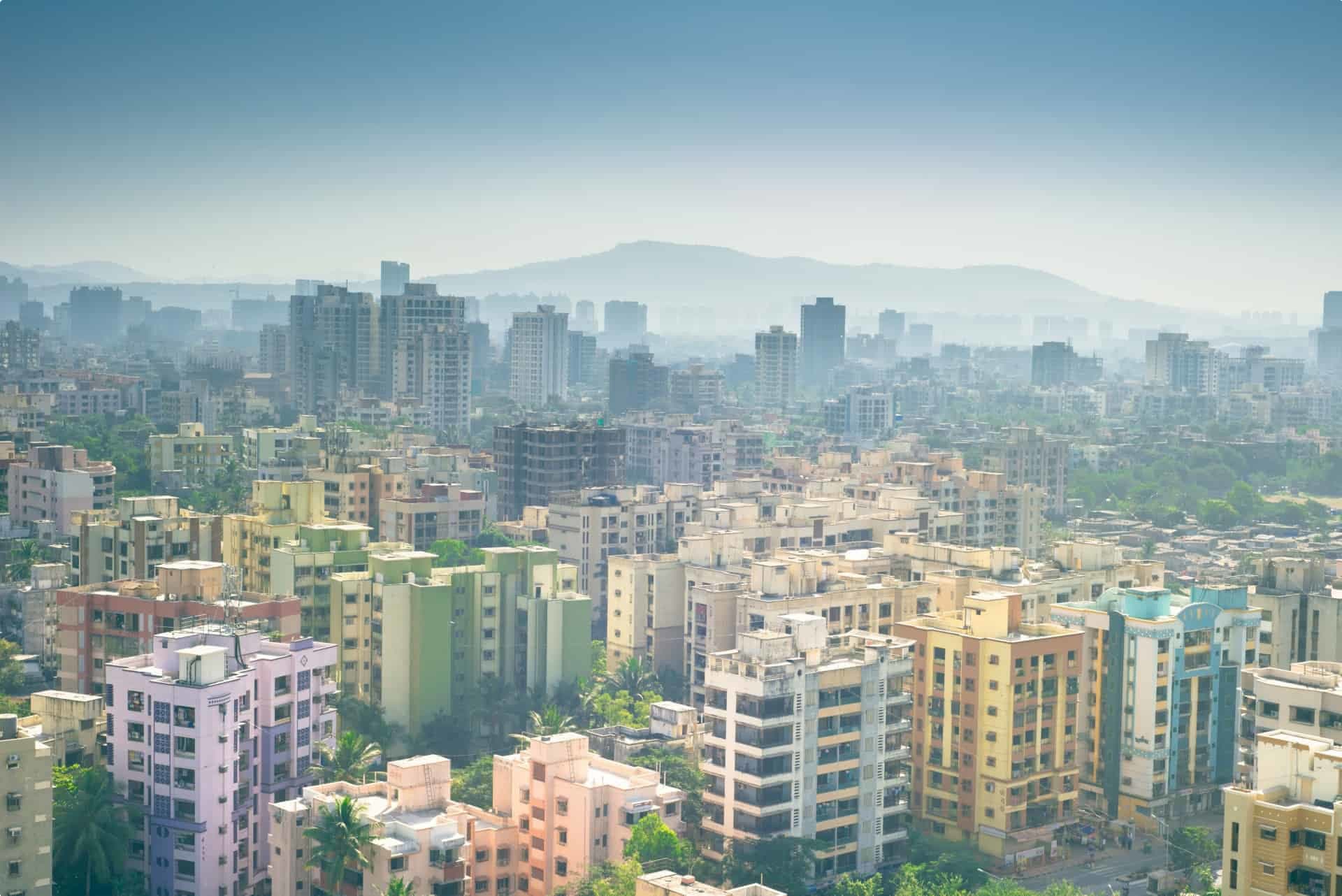
In 1662, Charles II of England married the infanta Portuguese Catherine of Braganza. The settlement was given to England as part of her dowry. In 1668 the English Crown leased the settlement to the British East India Company for a peppercorn rental. Mumbai was the first major English colonial settlement in India. A succession of governors invited merchants and traders to the new colony, thus setting the scene for later economic dominance.
The Industrial Revolution
The region around Mumbai produced excellent cotton that was highly sought after by the hungry textile mills of Lancashire and Yorkshire during the Industrial Revolution of the 18th and 19th centuries. Mumbai thus became the major export port for this trade. The disruption of the cotton industry of the southern United States during the Civil War of 1861 – 1865, together with the opening of the Suez Canal in 1869, gave a tremendous boost to Mumbai’s trade.
Mumbai has some outstanding architectural features of the British Raj and we will see many of them during our city tour. These include the famous Gateway of India at the harbour, built to commemorate the visit of King George V as Emperor of India, and Queen Mary in 1911. The last British troops marched through this arch in 1948 to leave India by ship following Independence in 1947.
Modern Mumbai
The 2008 film Slumdog Millionaire, which won 8 Academy awards, is set in Mumbai. It tells the story of an 18-year-old orphan who grew up in the slums, and whose shot at escaping poverty comes with his appearance on India’s version of Who Wants to Be a Millionaire? The film offers a poignant insight into the dark side of Mumbai: the extreme poverty experienced by many of its most vulnerable residents.
Elephanta Caves

One of the world-famous attractions of Mumbai is the Elephanta Caves, located on an island about one hour’s ferry ride across the harbour from the Gateway of India. The Elephanta Caves are a series of rock-cut Hindu shrines with interior sculptures carved during the 5th and 6th centuries. The Elephanta cave temples are a UNESCO World Heritage Site. They were originally called Ghaarapuri or “Fort-City,” but the island was renamed Elephanta by the Portuguese after a huge stone elephant that once stood here.
6. Mysore
The city of Mysore is centered around the spectacular walled Maharaja’s palace. This is one of the largest in India, and was only completed in 1912, after the earlier palace burnt down in 1897. The palace is a harmonious synthesis of the Hindu and Saracenic styles of architecture with magnificent archways, domes, turrets, colonnades, and sculptures. While here, stop in at the art gallery, and then drive up to Chamundi Hill to see Chamundeshwari Temple. This vantage point also provides panoramic views across Mysore.
Until Independence, Mysore was a princely state, with the Maharaja ruling over an area one third the size of the current state of Karnataka. Hyder Ali and his son Tipu Sultan usurped power for a brief period in the late 18th century.
Sandalwood oil and incense (agabarthi) are key items manufactured in Mysore by many of the 750,000 people who live there. There is a government run sandalwood oil factory, along with many small family run incense factories throughout the town area.
7. Wayanad
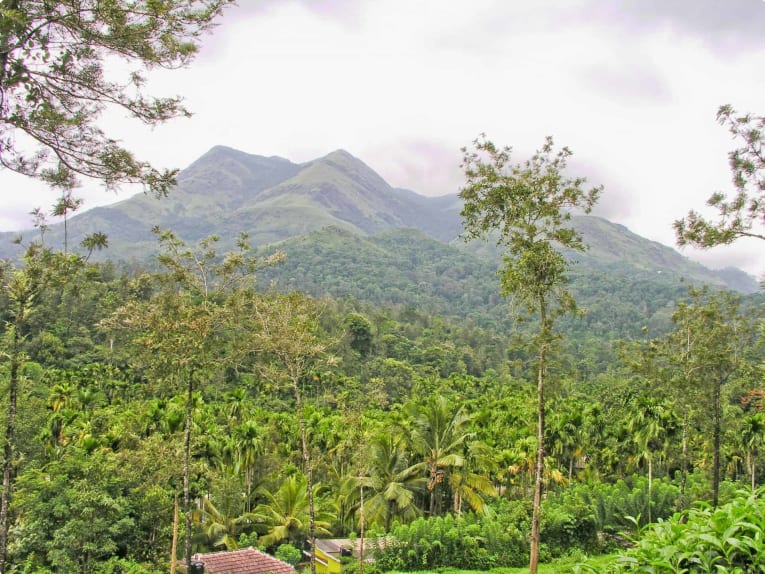
Wayanad district is in the north east corner of the state of Kerala. The main attraction is the imposing rugged terrain of the Western Ghats, with lofty ridges interspersed with dense forest, tangled jungles and deep valleys. At the centre of this natural area is the Nilgiri Biosphere Reserve. The sanctuary is rich in flora and fauna. Management of the reserve lays emphasis on scientific conservation with due consideration to the lifestyle of the people who live in and around the forest. Asian Elephant, the Nilgiri Tahr (ibex), spotted deer, bison, tiger, cheetah and wild bear can all be seen here.
8. Alleppey
The backwaters of Alleppey are some of the most popular tourist attractions in India. Sometimes referred to as the “Venice of the East”, the backwaters comprise some 900 kilometres of waterways that fringe the Arabian Sea and wind their way inland. The area around Champakulam forms part of the rice bowl of Kerala, and is resplendent in green paddy fields, coconut groves and water fowl. The town of Kumarakom is a serene, emerald green peninsula set in the backdrop of Vembanad Lake.
In Alleppey, consider spending time at an Auyrveda resort. Ayurvedic medicine is a Hindu system of traditional medicine native to India.. The earliest literature on Indian medical practice appeared during the Vedic period in India, i.e., in the mid-second millennium BCE. Treatment options are varied and can include yoga, acupuncture, herbal medicine, massage therapy and dietary changes.
9. Periyar
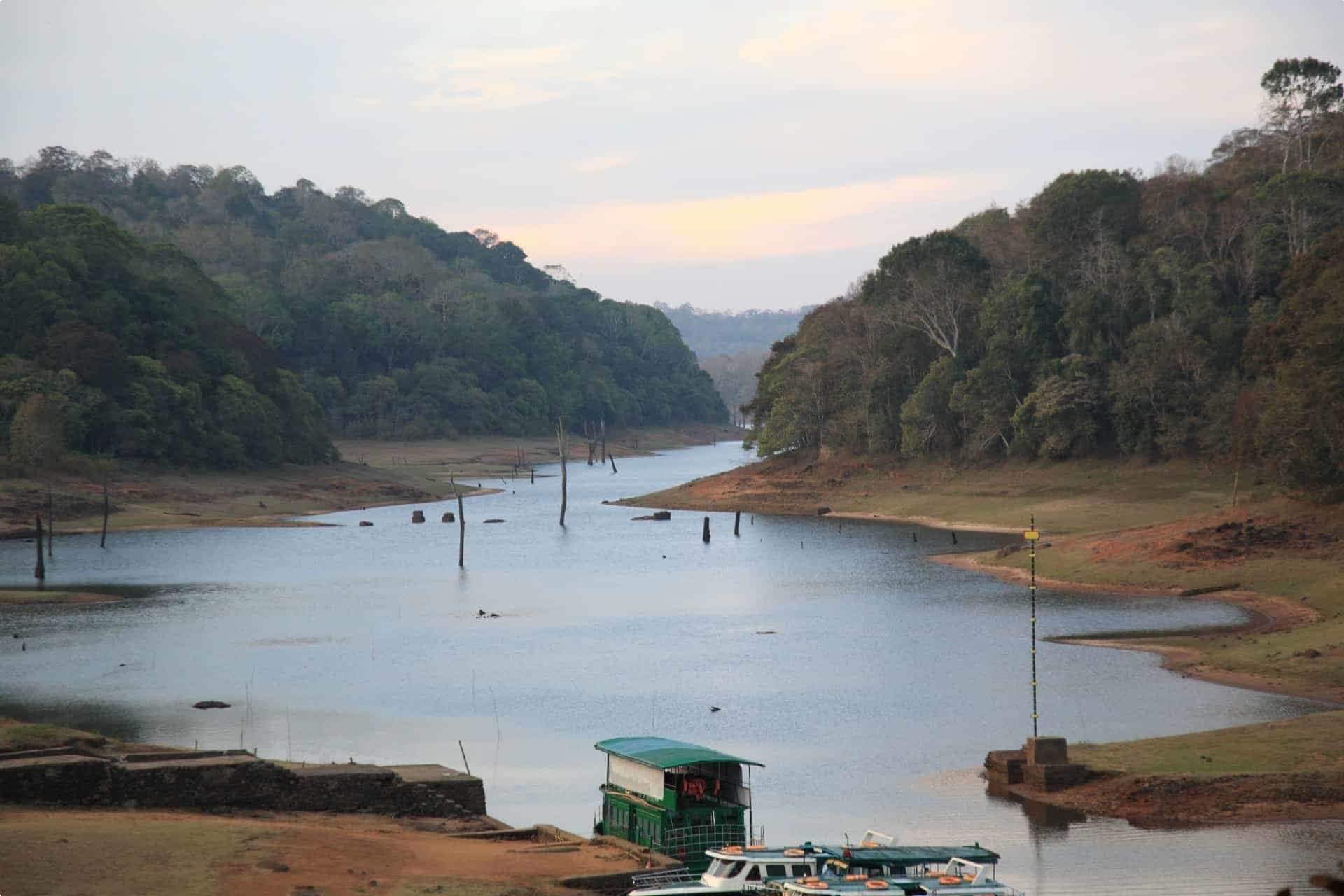
Periyar Tiger Reserve, covering an area of 925 square kilometres, was dedicated in 1978 as the 10th Tiger Reserve in India. Today there are 42 tiger reserves in India which are governed by Project Tiger and administered by the Indian National Tiger Conservation Authority. The 2010 National Tiger Assessment estimated the total population of tigers in India as 1,706. This exhaustive study indicated that better protected tiger source sites, especially tiger reserves, have maintained viable tiger populations. However, the area occupied by tigers outside protected areas has decreased considerably. This demonstrates the need for securing corridors for tigers to move between source sites. The existing tiger reserves represent around one-third of India’s high density forest area. There are an estimated 40 tigers in the Periyar National Park.
Community-based ecotourism is the hallmark of Periyar Tiger Reserve. These park centered programmes are conducted by local people responsible for the surveillance of the vulnerable parts of the reserve. By taking tourists along, they are involved in the conservation of the forests of Periyar and some valuable revenue is generated for community welfare. People who once made a living by illegal operations in the forests have since become forest protectors and earn their livelihood through these programmes. Odyssey Traveller encourages responsible tourism, and this recent article outlines other ways to create positive change on your travels.
Periyar’s other secrets
Though billed as a tiger reserve, Periyar is also famous for its wild elephants. Plus, it boasts a 115-year-old artificial lake. The construction of the Mullaperiyar Dam across the Periyar river at Thekkady submerged large tracts of land and created a huge lake, covering an area of 26 square kilometres (10 sq miles). Years later, in 1935, the then Maharaja of Travancore declared 600 square kilometres (232 sq miles) of forest surrounding the lake a wildlife sanctuary. The sanctuary is a rare example of human interference having enhanced rather than damaged an ecosystem. and is set in the beautiful thickly-forested Western ghats. Why not take a morning boat ride down Periyar Lake, and then a guided nature walk through the forest?
10. Cochin
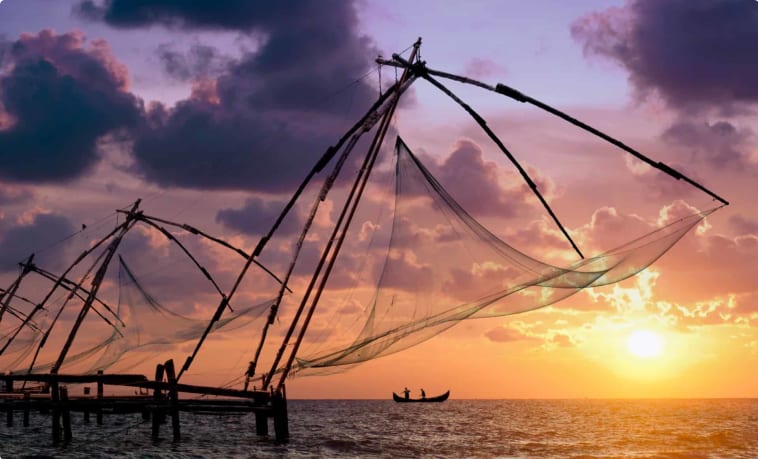
Fort Kochi, better known as Cochin, is Kerala’s most cosmopolitan city. It is also its main trading centre for spices and seafood. Built around a saltwater lagoon of the Arabian Sea, Kochi is in fact a collection of narrow islands and peninsulas. Cochin was settled by the Portuguese over 500 years ago. Vasco de Gama arrived on this coast in 1498, having sailed around the Cape of Good Hope to the western shores of India. The Portuguese established trading links in this area well before the British East India Company first started trading in the early 17th century. The population of 1.4 million comprises a melting pot of cultures. The winding streets lead to Portuguese houses, Chinese fishing nets, and architectural styles from the British and Dutch, along with a 16th century synagogue, and the oldest Christian Church in India (St Francis).
The scenic location of Cochin’s natural harbour, surrounded by palm groves, green fields, inland lakes, and backwaters, has enchanted visitors from across the globe for centuries. Cochin is a natural harbour created by the famed underwater Malabar mud-banks, whose quality ensures that the rougher seas are outside and the calmer waters are within the harbour.
While in Cochin, seek out a performance of the traditional dance of the Kerala region: the Kathakali. It is a highly stylized, classical Indian dance-drama, with elaborate make-up and costumes. The detailed gestures and well-defined body movements are complemented by stirring percussion.
The Mattancherry Palace, constructed by the Portuguese in the mid-1550s, was given to the ruler of Cochin as a token of goodwill in exchange for trading rights. It was later renovated by the Dutch, and so gained the misnomer: Dutch Palace. The 2-storied structure, built around a courtyard with a small shrine to the goddess Bhagavati, is today a museum with a rare collection of murals and royal artefacts. In the central Durbar Hall, where coronation ceremonies were once held, is the portrait gallery of the Kochi rulers; it also displays palanquins and textiles. The adjacent bedrooms and chambers are renowned for their fine 17th-century murals, representative of Kerala’s temple art, painted in rich, warm shades of red, yellow, black, and white. They depict religious and mythological themes as well as episodes from the Ramayana.
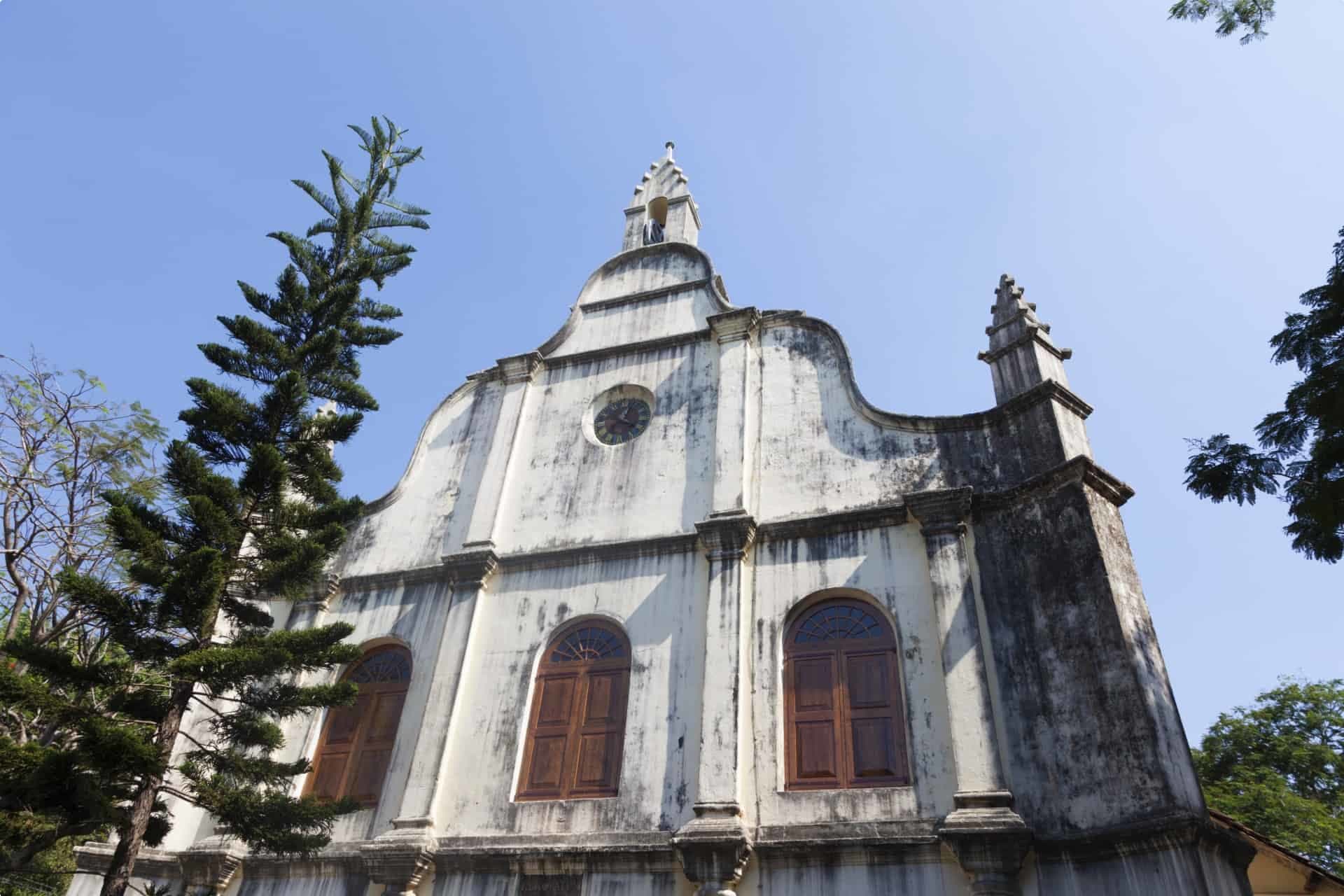
St. Francis Church was established in the early 1500’s by the Portuguese (who called it Santo Antonio). It is one of India’s earliest European churches, with a simple façade that became the model for later churches. Taken over by the Dutch and then the British, it is today affiliated with the church of South India. Within are numerous gravestones with inscriptions, the earliest a Portuguese epitaph dated 1562. Vasco da Gama was buried here in 1524 until his body was taken to Portugal 14 years later.
A Brief History of India
The history of India is often roughly divided into six periods. These are ancient India, medieval India, the years of the British East India Company, colonialism as part of The British Raj, the struggle for Independence, and, finally, post-Independence. India, the geopolitical entity as it stands today, is a post-Independence phenomenon. It was as recently as “the stroke of the midnight hour” on August 15 1947, when Nehru pronounced her “tryst with destiny” that India woke “to life and freedom”.
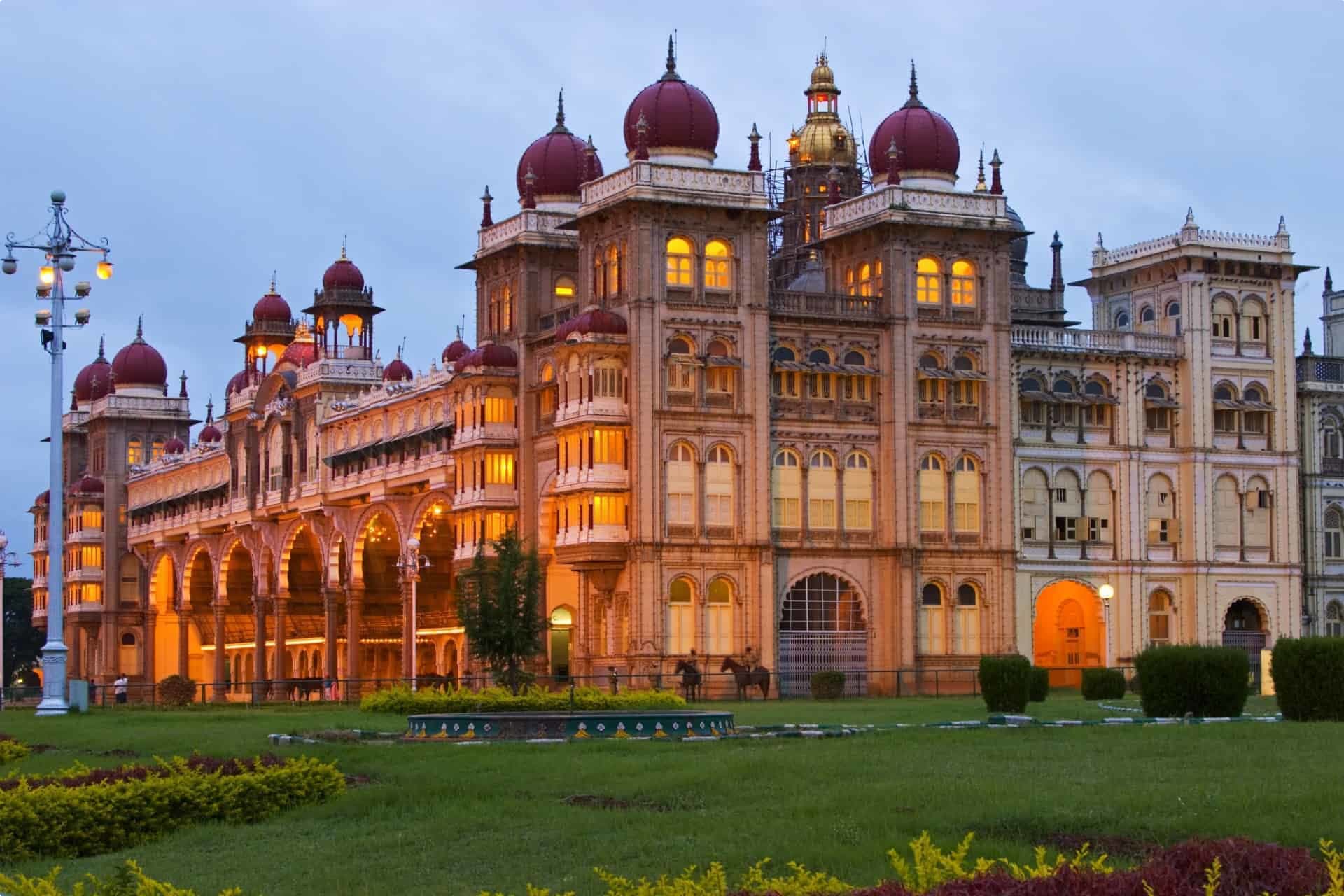
Ancient history
One of the world’s oldest civilizations was the settlement at the Indus Valley. The degree of sophistication that archaeologists found in their settlements almost belies the fact that these people lived 4,000 years ago. The civilization had meticulously planned cities; streets met at right angles, the sewage system was highly functional, and the tools and large granaries show that they had quite sophisticated agricultural knowledge and systems. Seals of the Indus Valley have on them the only ancient script that is yet to be deciphered. The most important Indus Valley cities of Harappa and Mohenjodaro are in present-day Pakistan.
The Indus Valley civilization died out in 1500 BC. The theories are a still a matter of contention. They range from the coming of the central Asian Aryan tribes, to the changing of the course of the Indus River. While both of these did, in fact, occur, it is difficult to attribute them with certainty to the end of the Dravidian civilization in the Indus valley.
By 300 BC, the previously-nomadic Aryans had settled down in the region of north India. They had brought with them Sanskrit, a member of the Indo-European family of languages akin to Latin and Greek. They also brought the spoken literature of the Hindu life-philosophy, horse-driven chariots and a social system of caste differentiation.
An era of empires
The following millennium saw the waxing and waning of empires. In the north, the great dynasties were those of the Mauryas (300 – 200 BC). During this period, Buddhism received royal patronage. It was similar for the Guptas (300 – 500 AD), during whose reign the subcontinent is said to have enjoyed a “golden period”. The intervening period had new settlers like the Shakas and Kushanas, who formed lesser kingdoms in the area around the Ganges. The influence of these Aryan kingdoms rarely reached the south. Regional dynasties like the Andhras, Cheras, Pandyas and Cholas ruled kingdoms in the south of the Deccan Plateau and lower down the peninsula. When unable to withstand the pressures of central Asian invaders, the Gupta Empire crumbled. The north was divided into strong regional kingdoms (except for a brief period from 606 to 647 under the poet king Harshavardhan). This was the time that the Rajputs grew to prominence in the west.
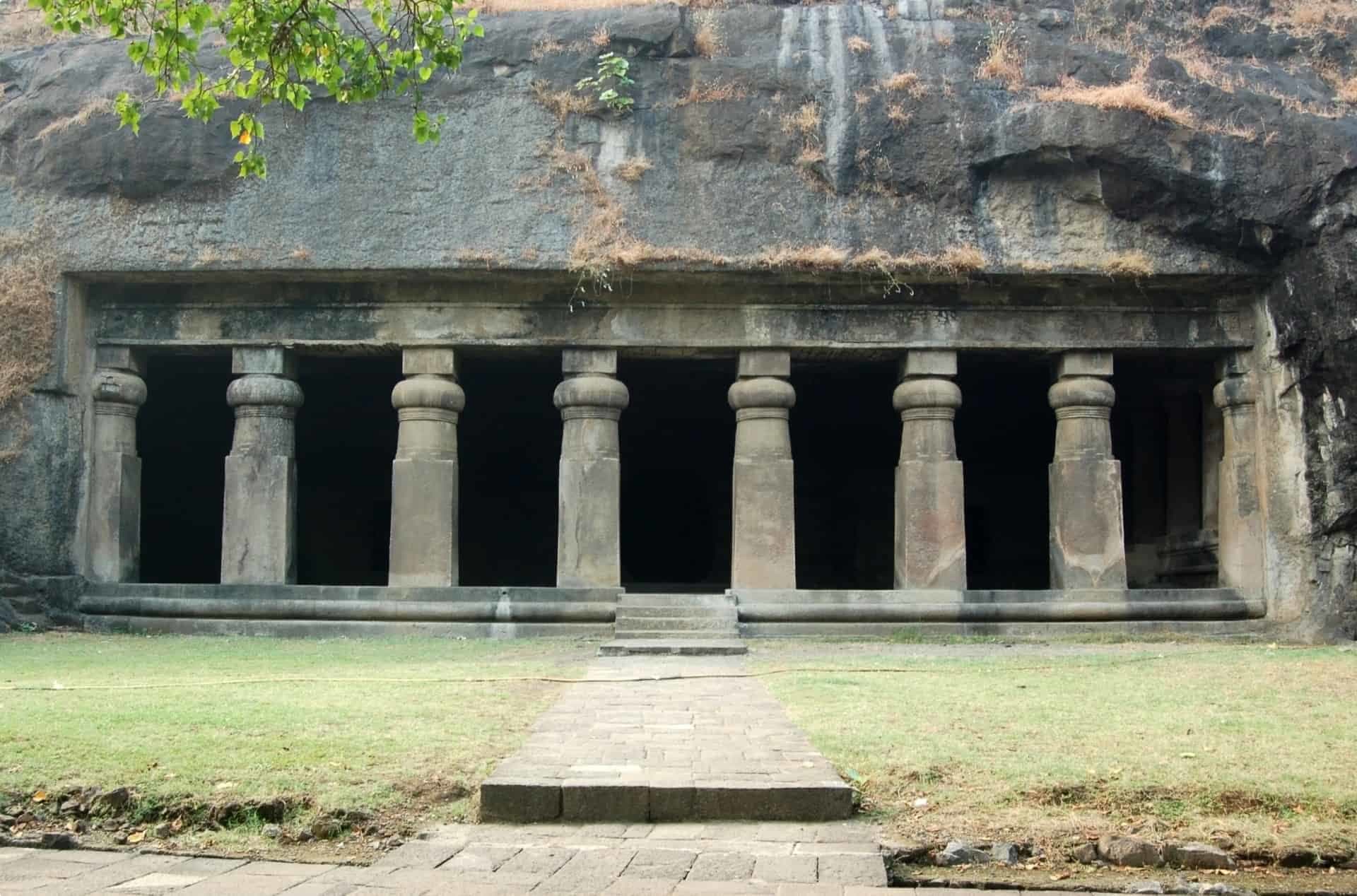
The arrival of Islam
Within 300 years of being founded in the 7th century, Islam had reached the western parts of India. It was not until the coming of Turkish-Afghan raiders like Mahmud of Ghazni (997 to 1030 AD) and Muhammad Ghauri (in 1192) that Islam made significant inroads to the heart of north India. The first Muslim empire was set up by a general of Ghauri’s: Qutb-ud-din Aibak. This was when the Delhi Sultanate came into being. The temptation of privileges extended to the faithful and Hinduism’s own severe caste system made many convert.
The founding of the Mughal dynasty
The Delhi Sultanate was riven with internal strife. It saw no less than five dynasties come to power between 1206 and 1526. In 1526, a young Central Asian warlord – who had already captured Kabul – set his eyes on the vast land that lay to the south. Tales of riches had reached his ears. Babur, descendent of Genghis Khan and Timurlane, made good his ancestral legacy by defeating the Sultanate’s armies in the Battle of Panipat. In a land of oppressive heat, and unfamiliar people and customs, Babur founded the Mughal dynasty.
Babur began the work of bringing the delicate patterns of Islamic art, the detailed craft of miniature painting and the symmetry of formal garden craft to Delhi. Until Aurangzeb, the 6th king of the dynasty, the Mughals had a liberal policy of religious tolerance.This helped them weave together a largely stable and tight-knit kingdom that spanned a territory larger than had any previous dynasty. It was a time of plenty, enabling emperors like Jehangir (1605 – 1627) and Shah Jehan (1628 – 1657) to focus their attentions on art, architecture and culture. During the Mughal dynasty, the Taj Mahal was built. So was the Red Fort, and the coffers contained the Koh-i-Noor and the ruby and emerald studded Peacock Throne.
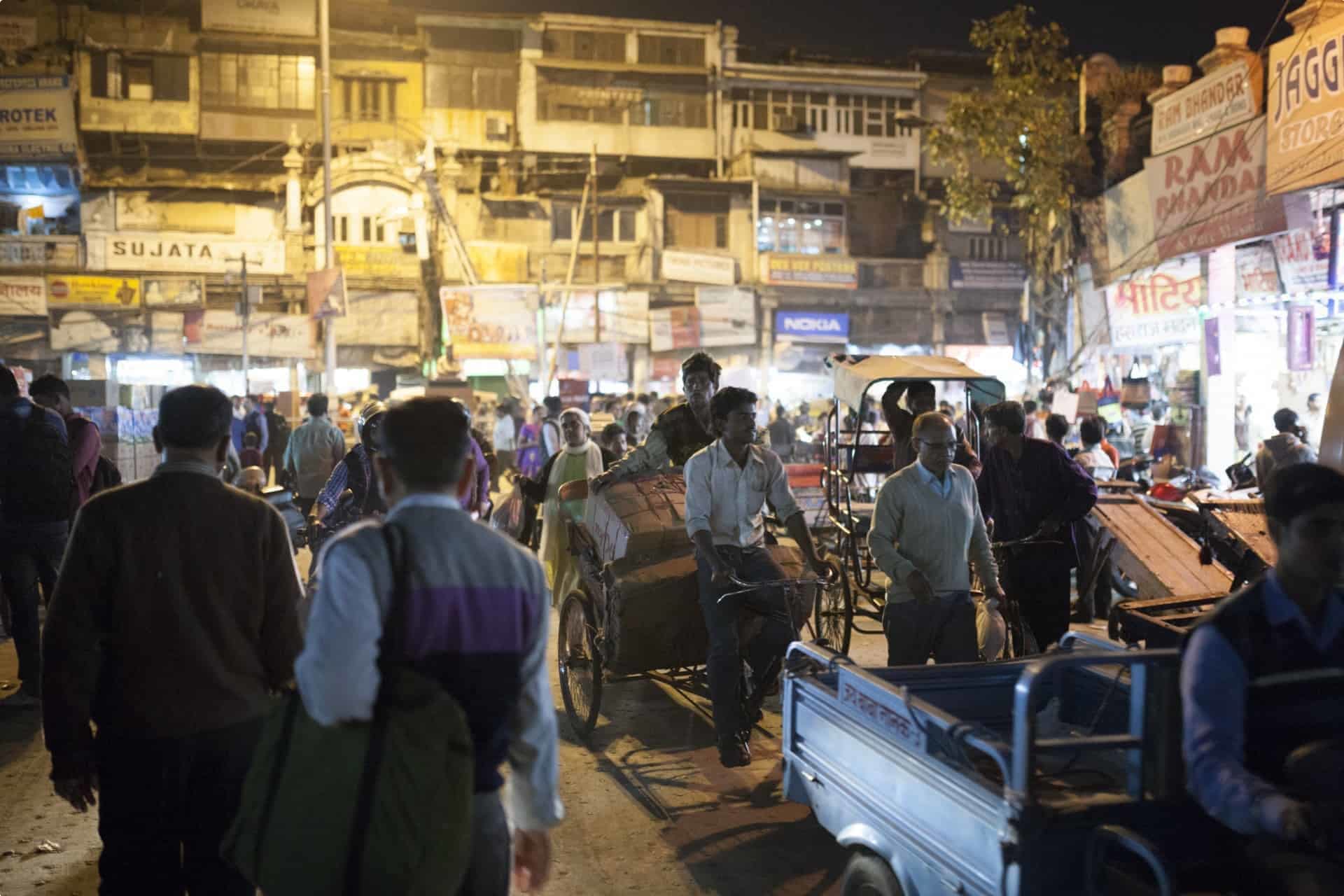
British colonialism
But Aurangzeb’s religious zeal won him widespread resentment. The Mughal Empire began unravelling, unable to withstand the Maratha chieftain Shivaji’s guerrilla warfare. Mughal king Bahadur Shah (1707 – 1712) is often considered the last effective leader. After the end of his reign, Mughal power and prestige declined steadily.
Meanwhile, the first British East India Company officials landed in India in 1602. Eventually, their interests ceased to be purely mercantile as they assumed more political roles. After the Revolt of 1857, the Crown took over the reins and India officially came to be a part of the British Empire. The Raj settled into ruling this vast dominion. They did so until 1947, when the country was handed back to the leaders of the freedom movement.
The freedom movement
Gandhi and Nehru led the largely non-violent movement from the front with the backing of Congress and the entire nation. However, partly because of the British ‘divide-and-rule’ policy and internal contradictions in the national movement itself, a communal divide came to be. When India finally achieved freedom, it was combined with the trauma of partition and the formation of Pakistan. Nehru became the first Prime Minister of India on August 15, 1947, as the head of a Congress government. The Congress hegemony ended in the late 60s, but it re-emerged intermittently through the 70s and 80s. The Nehru legacy was strong enough to make both his daughter Indira Gandhi, and later his grandson Rajiv Gandhi, Prime Ministers.
India in the twentieth century

Since independence, India has fought three major wars and one minor war with Pakistan. The Indo-Pakistani War of 1947 started over the control of Kashmir. The Indo-Pakistani War of 1965 was also fought over Kashmir. In 1971, India hosted refugees from East Pakistan. Additionally, they helped the Bangladeshi freedom fighters (Mukti Bahini) with resources and training during the Bangladesh Liberation War. During the final stages of that war, India became directly involved in the Indo-Pakistani War of 1971, which ultimately resulted in Pakistan’s defeat and the independence of Bangladesh. India also fought a border war with China in 1962.
Present-day India
India has an advanced space program designed to benefit the country economically, rather than merely create prestige. In the 1990s, following economic reform from the socialist-inspired economy of post-independence India, the country began to experience rapid economic growth. Markets opened for international competition and investment. In the 21st century, India is an emerging economic power with vast human and natural resources, and a huge knowledge base. Economists predict that by 2050, India will be among the top three economies of the world.
India still struggles with the legacy of a caste system. It originated as social-class based, but the arrival of the Aryan people saw it transferred to a system of colour. Though realignments have taken place across the centuries, some Indian people suffer from discrimination on this basis. Similarly, Indian women continue the fight to overcome institionalised sexism. India has achieved some progress in both areas, but there remains work to be done. The conditions that subjugate individuals because of poverty, lack of education and lack of employment opportunities remain the major barriers to equality.
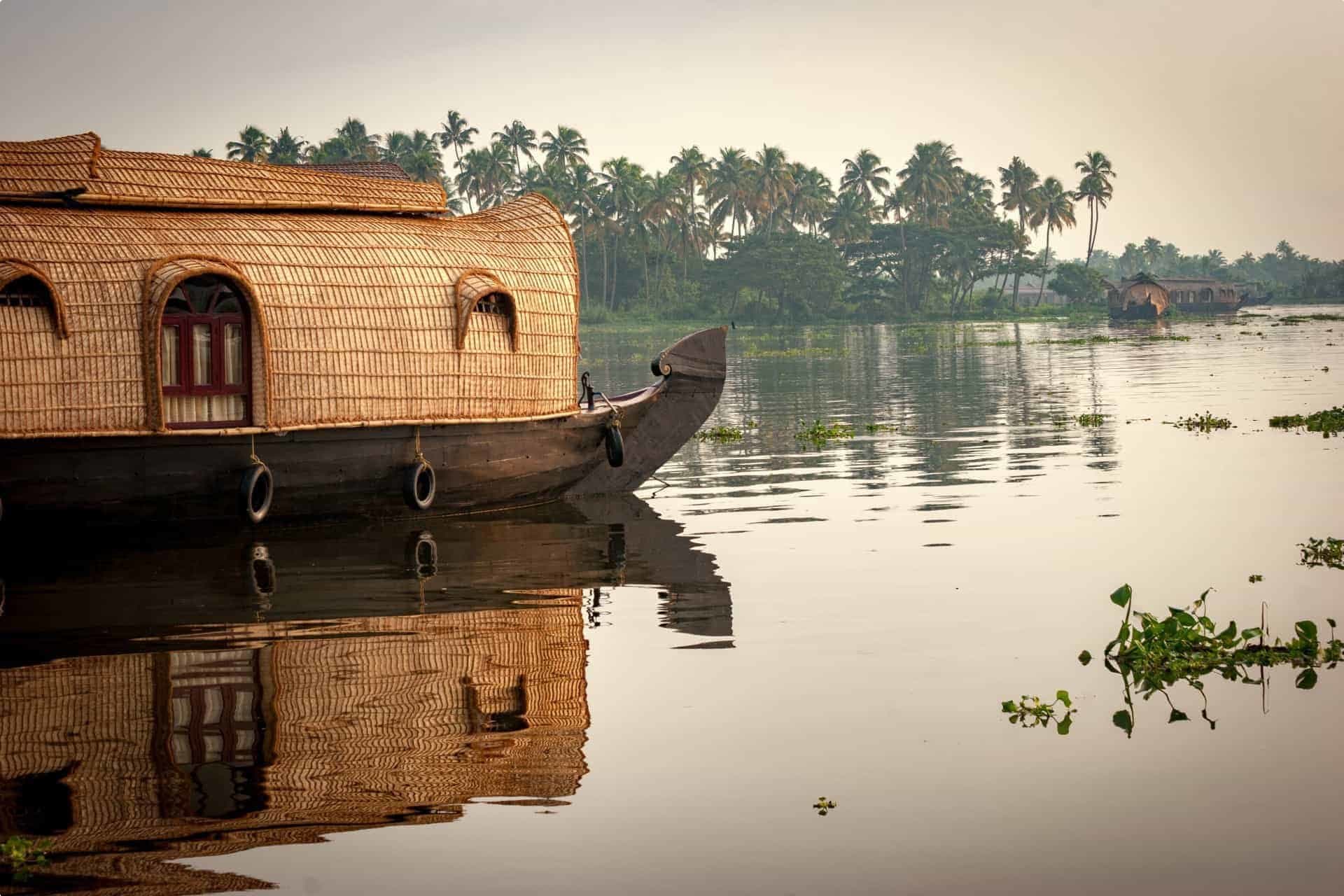
Climate
Weather and climate patterns are largely determined by India’s tropical and subtropical latitude and by the powerful summer and winter monsoonal wind systems. In the northern regions, higher elevations moderate temperatures.
The Indian sub-continent extends south from 32º N to 8º N so the country experiences a tropical climate with very high temperatures over most of the region. There is also a very powerful monsoonal atmospheric system which reverses between the summer and winter seasons (as in north-western Australia). During the northern hemisphere summer from May to September the continental heating produces the onshore South-West Monsoon which brings large hot, moist low pressure air masses from the Indian Ocean and Arabian Sea onto the west coast of India. These very unstable air masses continue across the Deccan Plateau and bring very heavy summer downpours with high humidity and frequent severe storms and flooding.
During the northern winter from October to April there is an outflow of cold high pressure air masses from the interior of the continent, with the North-East Monsoon. This monsoonal air flow produces cooler weather, clear skies and a long dry season with little or no rain.
A quick guide to Indian culture
- Music. Much of India’s classical music is devotional. Flute playing god, Krishna, is often its object. The North Indian Hindustani, and South Indian Carnatic streams are distinct. Both have a improvisational raga framework. Every region in India has a distinctive folk tradition too. Instruments that would typically accompany Indian music are the stringed veena, sitar, and the Indian drum tabla (or mridangam in the south).
- Dance. The classical dances of India are numerous. Characterised by stylised movements and elaborate costumes, these dances communicate age-old tales of love, longing and rage. Kathakali of Kerala, Bharatnatyam of Tamil Nadu, Kuchipudi of Andhra Pradesh, Manipuri and Odissi from Orissa are the prominent dance forms in this country that sways to an altogether novel beat. The robust bhangra of Punjabi men, the graceful whirling of Rajasthani women, the gentle sway of north-eastern dancers, vigorous tribal dances, every corner has developed its own unique form.
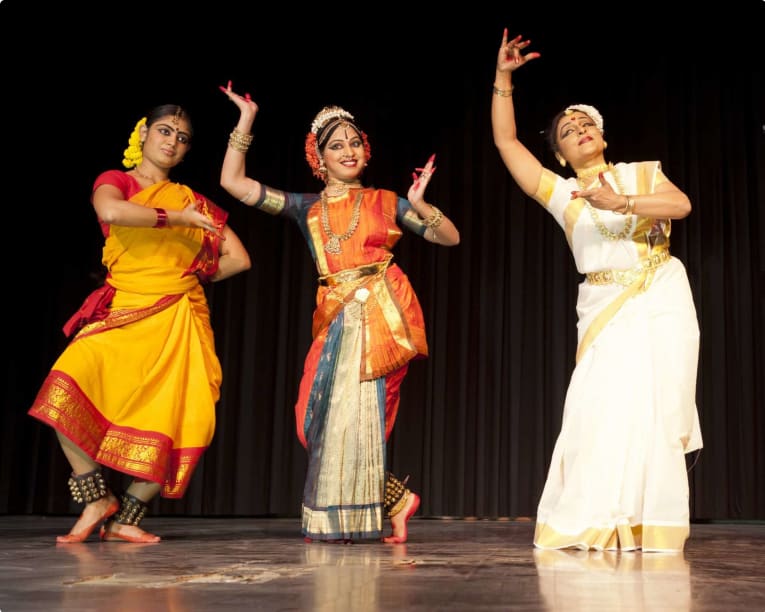
Traditional Indian dance - Theatre. India has a robust theatrical tradition. The Yakshagana nautanki and puppetry are ancient folk forms that live on. This tribe of wandering performers is sadly declining, but there are occasional performances on the rudimentary stages of rural areas. There is a growing body of contemporary work both in English and native languages.
- Art. The earliest specimens of Indian painting adorn the walls of 2nd century Ajanta Caves. The typical ‘figures in profile’ art of India came to be when the Jain manuscripts were being illustrated. The Mughals had a huge impact on Indian art. The miniature, which had been only on palm leaves in the north-east, came into prominence. The influence of Persian art brought placid garden scenes and illustrations from myths, legends and history into Indian art. Later schools include the Bengal School of Tagore and the Company School of European influence. More recently the opulent paintings of Raja Ravi Varma, the paintings of M.F. Hussain, Jamini Roy and Ganesh Pyne, among others, flourish in the art scene.
- Crafts. Woodcraft, handicrafts, architecture and sculpture all contribute to this rich and varied domain. Indian literature, both in English and in native languages, is ever more popular around the world. Handicrafts are as varied as the country itself. Diverse architecture exemplifies a rich history. Sculptures adorn temple walls, stupas, street junctions and ancient caves. The oldest schools are the Gandhara and the Mathura.
- Movies. The Hindi movie industry is the most prolific in the world. It is based in Bombay (now Mumbai), hence its designation Bollywood. There is sheer joy in the easy stereotypes of muscle-flexing machismo, leering villainy and leading ladies of Hindi film. But not all Hindi films are a simmering brew of action, romance, song and dance. There is a parallel stream of art cinema, though it’s not nearly as famous as the commercial stream.
- Cricket! India grinds to a halt when the country’s eleven don their whites. In cricket-crazy Kolkata, fans gather to trash the new-fangled limited-overs format (let alone the more recent 20-20!). Millions pray for victory (often knowing they’re praying for a miracle!). For children growing up in poverty, practising endlessly in the dirt, cricket can perhaps offer a way out. Thegreatest Indian cricketer of them all (arguably one of the two or three greatest cricketers of all time) is Sachin Tendulkar. He is afforded a status somewhere between a rock-star and a none-too-minor deity.
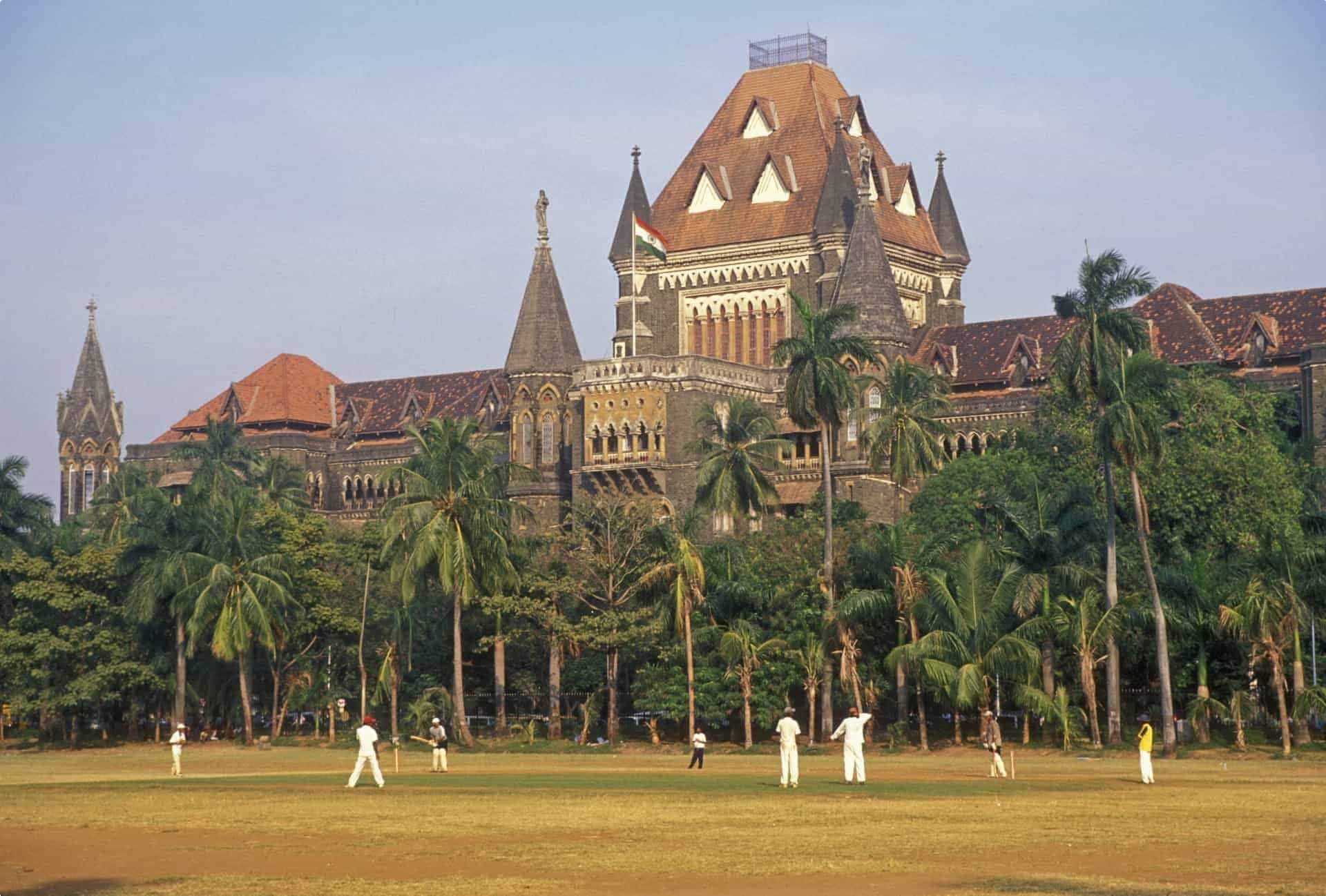
A game of cricket in front of Mumbai’s High Court building
Tips for senior travellers in India
- Indian people strictly use their right hand for ‘clean’ tasks, such as eating or passing change. Try to practice this yourself, particularly if you are eating in a local restaurant. To eat bread, use your forefinger to hold it to the plate, and your thumb to tear bits from it. For rice, compress it into a ball using your right hand, and dip it into curries or sauces. Some ‘higher class’ restaurants may provide cutlery – look around and follow the lead of your neighbours!
- Feet are considered unclean in India. Avoid touching anyone with your feet or shoes, or pointing the soles of your feet at someone. A quick apology should suffice if you do this by mistake.
- Touching is not a common part of greeting, particularly when greeting women. If in doubt, wait for someone to offer their hand, rather than extending your own.
- The naming conventions differ according to region; some men have family names, others are given the name of their father or ancestral village. When addressing a person, it is advised to prefix their name with Mr, Mrs, or Miss, or Doctor/Professor if applicable. They will soon indicate whether you may use an informal address – this is usually reserved for close acquaintances, family, or those with seniority by age or authority.
- Indian people rarely engage in direct disagreement. To do so is considered hostile, so bear this in mind in your communication with the locals.
- Indians are a generally tolerant people, and welcome other religions, etc. Certain topics of conversation are quite emotional though: avoid mention of neighbouring Pakistan, as well as the poverty issues. If a foreigner initiates this sort of conversation, it is interpreted as impolite criticism.
- On the other hand, genuine inquiries about religion and rituals will generally be met with great enthusiasm. India is a proud country, and many people will happily discuss traditions and history to travellers who show an interest.
- Though times are changing, it is still advised to be conservative in dress – especially when visiting temples. Long pants or skirts are favoured over shorts, and women should cover their shoulders . We recommend women pack a light scarf – this will come in handy to wrap around you when appropriate.
- Photographing airports, military establishments and dams is illegal in India. Some temples also prohibit photography. Additionally, it may be frowned upon at train stations, bridges and border regions too. Exercise common sense here, and if in doubt, ask somebody. It is especially important to seek permission before photographing people.
- Practice personal safety measures including locking your suitcase and keeping personal belongings close. Avoid accepting food from strangers due to risk of contamination, and resist the urge to pat cats and dogs – animals may carry worms, and rabies is a remote risk.
- Drink bottled water and choose well-cooked fresh food over salads. Don’t drink unpasteurised milk, and avoid ice cream for the same reason. Take care with items like shellfish. On the whole, Indian food is delicious, varied and unique. And experiencing local delicacies can be a great way to immerse yourself in the culture of the region. Your leader and local guide will be helpful resources for how to make the most of your time here.
Tours to India for senior travellers

Odyssey offers more than 140 scheduled small group tours to people from all over the world. Odyssey travellers share our passion for exploring and learning. The 22 day small group tour of India for seniors is offered in November each year. It is also available as a short tour option. This article focuses on central and south India. If you are interested in breathtaking north-east India, taking in the Himalayas, Darjeeling and Bengali, you might like to check out our North East India small group escorted cultural tours for seniors, which is planned for an October departure.
About Odyssey Traveller: small group educational tours for seniors & mature travellers
Odyssey Traveller is a not-for-profit organisation offering Australia and New Zealand’s most comprehensive educational tour programs. We provide worldwide experiences for mature travellers who are keen to blend a love of travel with a thirst for knowledge, and we welcome participants from any country.
Odyssey Traveller is famous for our small groups, and we average eight participants per tour. Our maximum group size is eighteen people, which ensures quality, flexibility and care that is tailored to our clients. We specialise in small group tours for the senior traveller who is seeking adventure or is curious about the world we live in. Typically, our clients begin travelling with us from their mid 50’s onward. Both couples and singles are welcome.

Odyssey Traveller is committed to charitable activities that support the environment and cultural development of Australian and New Zealand communities. Accordingly, we are pleased to announce that since 2012, Odyssey has been awarding $10,000 Equity & Merit Cash Scholarships each year. Scholarships are awarded on the basis of academic performance and demonstrated financial need. We award at least one scholarship per year. We are supported through our educational travel programs, and your participation helps Odyssey achieve its goals.
For more information on Odyssey Traveller and our educational small group tours, visit our website. Alternatively, please call or send an email. We’d love to hear from you!
Related Tours
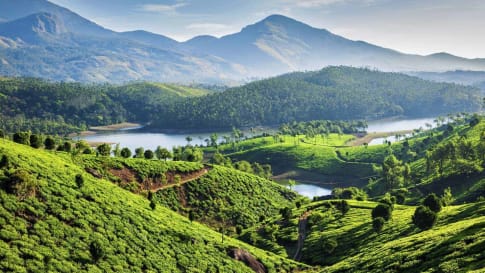
22 days
Nov, MarCultural and History Tour of India | Small Group Tour
Visiting India
Small group tour for mature and senior couples and solo travellers to India. Visiting Delhi and the red fort, Jaipur, Agra and so much more over 22 days explore the world of the Mughal.
From A$12,300 AUD
View Tour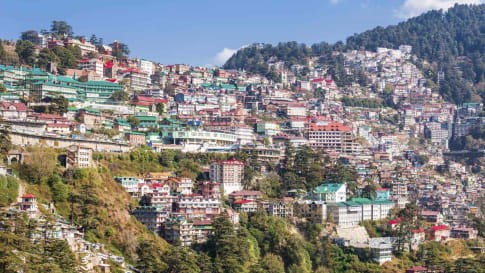
15 days
OctNorth East India small group escorted cultural tour
Visiting India
A unique small group cultural tour visiting the North East region of India, this tour was created for seniors travelling as couples and solo travellers. As we journey through the magnificent landscape and culture we stop to explore Darjeeling, which shares history with Bengal, Sikkim, and Nepal, as well as Tiger Hill, where we witness the changing colours of the sunrise in the Himalayan Range.
From A$9,750 AUD
View Tour
11 days
Nov, Mar, OctIndia Short Tour | Small group tour for seniors
Visiting India
A short small group tour for Mature and seniors couples and solo travellers of India and its icons. Bounded by the majestic Himalayan ranges in the north and edged by an endless stretch of golden beaches. India is a vivid kaleidoscope of landscapes, magnificent historical sites, such as the Taj or red fort royal cities, such Dehli, Jaipur , Agra and Madras colourful people, and rich culture.
From A$9,250 AUD
View Tour